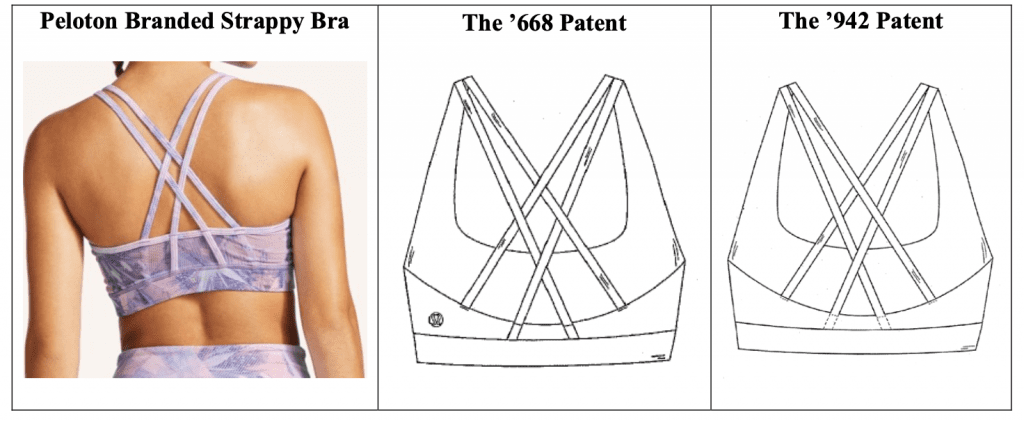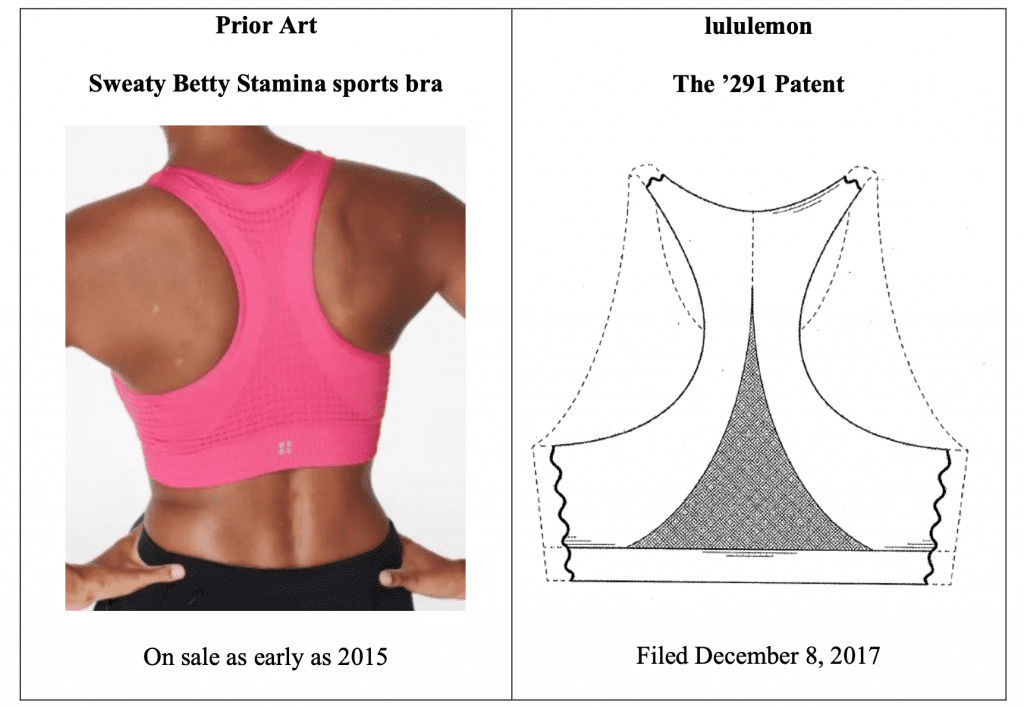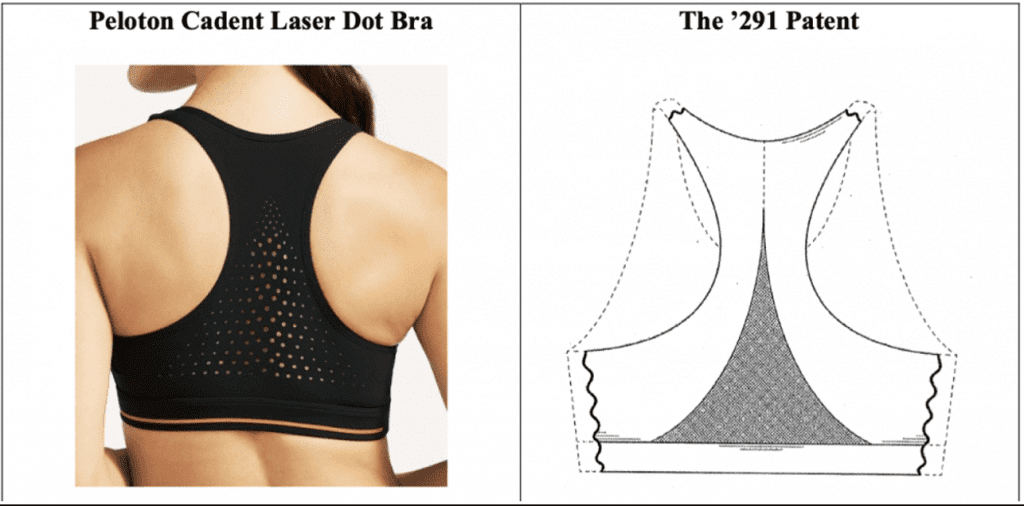A behind the scenes scuffle between Lululemon and Peloton has spilled over into federal court, with the exercise bike -maker arguing that Lululemon recently threatened it with litigation over its “similarly striking” garments. According to the declaratory judgment action that it filed with the U.S. District Court for the Southern District of New York on November 24, Peloton claims that just over two months after it launched an activewear collection of its own and terminated its 5-year apparel partnership with Lululemon, the Vancouver-based athleticwear company has alleged that a handful of Peloton’s private label products infringe its design patents, and that a pair of Peloton-branded leggings infringes its trade dress rights.
Setting the stage in its complaint, Peloton asserts that “in addition to being the world’s leading interactive fitness platform, [it] has its own private label apparel brand, Peloton Apparel.” While the New York-based company claims that it first began selling apparel from other brands to its exercise equipment members in 2014, “in response to member demand, it officially launched its private label line in September 2021.”
Ahead of launching its own in-house collection, Peloton claims that it ended its existing partnership with Lululemon. “At the time, the termination of the Peloton-Lululemon co-branding relationship” – which saw Peloton sell a variety of Lululemon apparel products co-branded with its own name/logo – “was amicable,” Peloton asserts, noting that Lululemon “did not object in any way to Peloton’s termination decision or Peloton’s offering of its own active wear apparel.”
That changed earlier this month, however, according Peloton, as it says that it received a cease-and-desist letter from Lululemon on November 11, in which Lululemon alleged that five of Peloton’s branded and private label activewear apparel products – namely, Peloton’s Strappy Bra, High Neck Bra, Cadent Peak Bra, and Cadent Laser Dot Bra – infringe its design patents, and that another one of the Peloton-branded activewear apparel products – the Cadent Laser Dot Leggings – infringe its trade dress rights.

In the November 11 cease-and-desist letter, Peloton claims that counsel for Lululemon stated that unless Peloton cease selling the allegedly infringing products, it would file an infringement lawsuit.
Instead of complying with Lululemon’s demands, Peloton filed a declaratory judgment action, asking a court to settle the matter by way of a declaration that: “(1) Peloton has not infringed, and does not infringe upon the asserted Lululemon patents; (2) the asserted Lululemon patents are invalid; and/or (3) Peloton has not infringed, and does not infringe, upon any purported Lululemon trade dress rights.” (When a party is threatened with a design patent infringement lawsuit (or another type of infringement suit), it may preemptively sue the rights holder, Lululemon in this case, in a declaratory judgment action and seek to have the allegedly infringed design patent declared invalid or not infringed.)
Peloton’s Patent Pushback
First addressing Lululemon’s patent infringement claims, Peloton argues that the company’s allegations “lack any merit,” as “even a quick comparison of the Lululemon patented designs with the allegedly infringing Peloton products reveals numerous clear and obvious differences that allow the products to be easily distinguished.” Beyond that, even if the products are sufficiently similar, Peloton asserts that Lululemon’s “claimed design patents are invalid because, at a minimum, they are anticipated and/or obvious and, thus, cannot be infringed upon.”
It is worth specifying here that Lululemon is claiming design patent rights – i.e., rights that protect the overall visual appearance of an article of manufacture, including the color and shape of a product or a combination thereof – in the specific “ornamental design” of its apparel products. Here that takes the form of the design elements of various sports bras and a pair of leggings. Essentially, it is arguing protection in the way those things look, as distinct from the way they work, the latter of which falls in the realm of utility patents.
Pushing back against Lululemon’s infringement claims, Peloton sheds light on some of the limitations of design patents, primarily, that protection exists only for new designs, or more specifically, novel and non-obvious ones. Here, Peloton claims that various prior art – including previously-released designs from Sweaty Betty, among other companies – makes it so that the sports bra and leggings design elements were already “anticipated or would have been obvious” at the time that Lululemon filed its patent applications. As a result, Peloton claims that has noted infringed Lululemon’s sports bra patents and that Lululemon’s patents are invalid due to a lack of novelty and/or non-obviousness, and thus, “cannot be infringed upon.”

Aside from taking issue with the validity of the patents that Lululemon relies upon to make its threatened case, Peloton asserts that the court should issue a declaration in its favor because there are “clear and obvious differences” between its sportswear garments and Lululemon’s patented designs.
Citing some of the “key differences” between its Cadent Laser Dot bra and the ornamental design at the center of Lululemon’s D836,291 patent, Peloton argues that the ’291 patent “claims a translucent, transparent, or see-through mesh or fabric, whereas the dotted pattern on [its] Cadent Laser Dot Bra is a pattern cut into the fabric of the bra itself.” Moreover, “The shape of the insert claimed in the ’291 patent is also different from that of [its] product,” per Peloton, as the ’291 patent “shows a triangle with two rounded sides,” whereas its “unique dotted pattern is more similar to a Christmas tree shape.”
These differences, among others, are noteworthy, as the successful enforcement of a design patent requires that an “ordinary observer” – with knowledge of the prior art and “giving such attention as a purchaser usually gives” – would find the accused product and the patented design to appear to be “substantially the same.”
(Since the Federal Circuit decided the Egyptian Goddess, Inc. v. Swisa, Inc. case in 2008, the sole test for determining whether a design patent has been infringed is the ordinary observer test. The caveat here is that only non-functional elements and ornamental aspects of functional elements can be considered as part of the “ordinary observer” analysis, and thus, if the differences between these points of novelty and the accused design “are such that the overall design of the patented and accused product are not substantially the same, a finding of infringement is inappropriate.”)
While Peloton does not make functionality claims in its complaint, it does argue that “clear differences” between its products and those depicted in Lululemon’s patents stand in the way of an ordinary observer finding that the respective designs are similar enough to amount to infringement. Still yet, what Peloton does not explicitly argue – but what is, nonetheless, worth noting – is that the breadth of Lululemon’s hypothetical patent infringement claims (i.e., the ones that it makes in its cease-and-desist letter) is confined to the actually-claimed designs that are depicted in its patent drawings and does not extend to general design concepts, such as a sports bra. The Federal Circuit has repeatedly held this, stating that the scope of a patent is limited to the “overall ornamental visual impression, rather than to the broader general design concept.”
As such, differences in the appearance of Peloton’s offerings and the designs shown in Lululemon’s patents are significant.

On the Trademark Front
In its complaint, Peloton also shoots down Lululemon’s trademark claim, asserting that its rival fails when it comes to likelihood of confusion, which is the critical element for determining infringement in a trademark context. In addition to “numerous clear and obvious differences in design,” confusion between the two companies’ products is “a virtual impossibility,” it argues, as “[its] and Lululemon’s brands and logos are also distinctive and well-recognized” – and clearly depicted on the companies’ respective products.
At issue is Lululemon’s Align trade dress, which it claims that Peloton has infringed by selling the Peloton One Luxe Tights. On this front, Peloton takes issue with the Align trade dress, itself, arguing that Lululemon lacks rights in the configuration, as “the features of the Align pant are ornamental and fail to function as a source identifier.” In case they are not ornamental, Peloton claims that Lululemon still does not maintain rights in the design of the Align pants, as the elements that it consists of “(i) are not distinctive such that they may function as a source identifier, and (ii) have not acquired distinctiveness and/or secondary meaning so that they may function as a source identifier.”
(The acquired distinctiveness part is important, as the Supreme Court previously established that a product design can never be inherently distinctive. As such, in order for product design trade dress to be protectable, the purported trade dress holder must establish that it has acquired secondary meaning.)
And still yet, Peloton asserts that even if Lululemon’s purported Align trade dress was protectable, its One Luxe leggings do not infringe that trade dress because consumers are not likely to be confused, as its branding appears on its leggings and the same is true for Lululemon. (This point could also be relevant from a design patent infringement perspective in light of the Federal Circuit’s holding in the Columbia Sportswear v. Seirus case, which “suggests that logo placement can be an important factor in assessing design patent infringement, particularly when the logo is an integral part of the accused design. In light of this, an infringer could potentially avoid infringement through logo placement on the allegedly infringing design.”)
With the foregoing in mind, Peloton is seeking a declaration from the court that it has not infringed Lululemon’s design patents or its trade dress, as well as declarations that the patents and trade dress are in valid and unenforceable. Peloton is also seeking reasonable attorneys’ fees and costs, and “any other relief the Court may consider equitable, just, and proper.”
In a statement on Friday, a representative for Lululemon said in connection with the newly-filed case, “At Lululemon we are known for our product innovation and iconic design. We will defend our proprietary rights to protect the integrity of our brand and to safeguard our intellectual property.”
The case is Peloton Interactive, Inc. v. Lululemon Athletica Canada Inc., 1:21-cv-10071 (SDNY).











